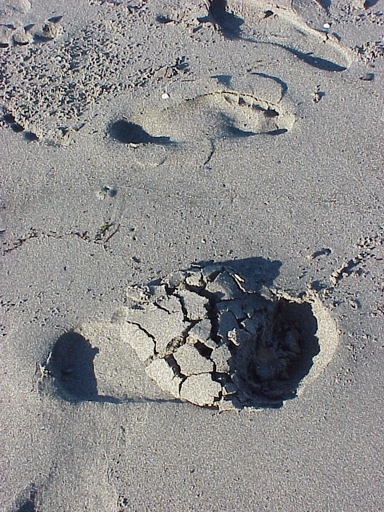
October 28, 2005
(Nine Inch Nails – Every Day Is Exactly The Same)
Why haven’t we discovered Sasquatch yet? Why are there no bones? Surely they have to die sometime. Questions that keep coming up in conversations I have with people after the initial shock of them realizing that I actually look for this imaginary beast. How could something like this be unknown in this day and age? Don’t we have spy satellites that can read license plates from 600 miles altitude? Something should surely have been seen with them. Don’t we have a lot of forest workers out there daily who do not see these animals? Where did they come from? Isn’t it all just a joke pulled off by some people in Yakima and that guy who just died… making those fake tracks wherever he did construction work?

Here are my answers to some of these and if they don’t like them or understand them… Oh well.
1. Sasquatch must have a very low population number. The DNR decided to re-introduce the Grizzly bear into Washington State recently. They set free 50 of the animals in the north cascades. This must then be enough animals to re-establish a viable population in their minds. If the population were higher like say for elk or deer (100’s of thousands), we most certainly would have proof of their existence by now. Repeat encounters with the species would be much higher in number.
2. Sasquatch appear in reports mostly as single entities. It is rare to read of encounters with more than one animal at a time. If they form a troop or family unit then they must be hiding this fact, on purpose or inadvertently. This logic dictates a low impact on the environment resulting in less interpretable sign. This could also be because the encounter occurred on the boundary of a home range, where individuals would be more likely seen than a defined unit set.
3. Home ranges are probably on par with that of Grizzly (with of course differences between genders), which can be around 1,000 square miles. Traveling these great distances (up to 100 miles a day) on landscapes that inhibit transportation equipment used by man has them far outpacing any would be pursuers.
4. Remote camera traps are starting to be used more and more but the expense of maintaining an operable string of them exceeds their original cost. These are also limited in distance (trigger, focal length and flash) and field of view (usually setup with a wide angle lens).
5. They live in very remote locations. Reports of people seeing these animals can not be where the animals actually live. These reports are just as much about the human as that of the Sasquatch. Sasquatch are probably making mistakes when they encounter humans. When we read reports posted on the web by different organizations or in books we are actually seeing only the errors being made.
6. Nobody is really seriously looking for them. Studying something like a low population primate in areas like the Pacific Northwest is more than a part time job or weekend hobby for a few amateur researchers. It would require a lot of resources (time, energy and finance) to cover even a small part of a suspected habitat. Even the people who have written on the subject have not spent a significant amount of contiguous time in one area. Most seem to think that skipping from one location to another is better than staying in one area. Researchers need to maintain a personal life and meet obligations and debts. There are no grants considered for this line of inquiry that other primate studies aren’t ahead of in queue.
7. The species are intelligent enough or exhibit behavior that avoids human interaction. Primates by their very nature are reclusive. Perceived threats are judged by distance to that threat and body size. If an escape route is present it will take that versus any direct conflict.
8. Note should be made that aggressive behavior of the Sasquatch in certain locations could indicate interactions closer to a core region of the home range. Intimidation wards off would be research in areas or the animals just vacate. These areas sometimes appear near off limit sites posted by Department of Fish and Game personnel or City watersheds, supposedly for other species and safety reasons.
9. They most likely have a high-energy diet. A low energy diet like that of Mountain Gorillas would have the animals staying more in one area for longer periods of time and produce a great amount of sign, including scat and browsing. Not too many reports showing these items.
10. They do not compete directly with humans for resources. We would have more interaction with Sasquatch if we shared the same resources – even more so if at the same time. If we were both using only daylight hours and there was only one water source and we both ate just a certain type of food source located in one specific spot… we would have to run into one another.
11. Sasquatch reports indicate either they are for the most part crepuscular or nocturnal. This is a time period where humans, with limited vision and the ability to manipulate their immediate environment have retreated from. Humans venture at night mostly in vehicles that cut them off from the environment until they can fully retreat into dwellings.
12. The majority of Sasquatch researchers have been of the male gender. There maybe something preventing males from directly interacting or observing a self aware primate such as the Sasquatch.
13. Current amateur research is funded personally and so there are no standards employed. Reinventing the wheel seems to take place about every ten years or so. Tribal knowledge is held in check and not distributed.
14. Current amateur research groups spend more time discussing the problem then doing coordinated field research.
15. Weather conditions in the Pacific Northwest usually affect long range viewing practices in the negative. Fog, rain and snow limit visual observations.
16. Property with suitable habitat is not available to conduct research on. Private, FS, DNR, DOD and Native American land ownership prevents free usage and is parceled for human benefit, not the animals. Sasquatch ranges and territories would not be defined by man-made boundaries.
17. Geographical isolating boundaries for these animals are less than for humans. They can probably cross raging streams, traverse snow covered mountains, etc. quite easily where as man must use technology and thus be prepared to encounter these obstacles while in pursuit.
18. I have been told by a very reliable source, who likes to play the devil’s advocate in public most of the time, that we may already have bones of these animals but mislabeled them or that they are still in storage. Scientists stake their work, invest in a line of inquiry ever decreasing in dimension until a miniscule attribute of a topic can be described accurately and normalized for others. Bones labeled early man may in fact only be of early apes and not that of man, because there is little to no funding for apes. Sounds familiar.
(Norman Greenbaum – Spirit in the Sky)

About Rick Noll
Rick Noll has been actively searching for the Sasquatch since 1969 and continues his pursuit with extended field trips into the Pacific Northwest's most remote regions. Rick has worked with Peter Byrne, René Dahinden, Grover Krantz, John Green, Jeff Meldrum and the BFRO during all this. He helped with many documentaries on the subject including Animal X: The Skookum Expedition and Sasquatch: Legend Meets Science.
Filed under Bigfoot, Bigfoot Hunter, Cryptozoology